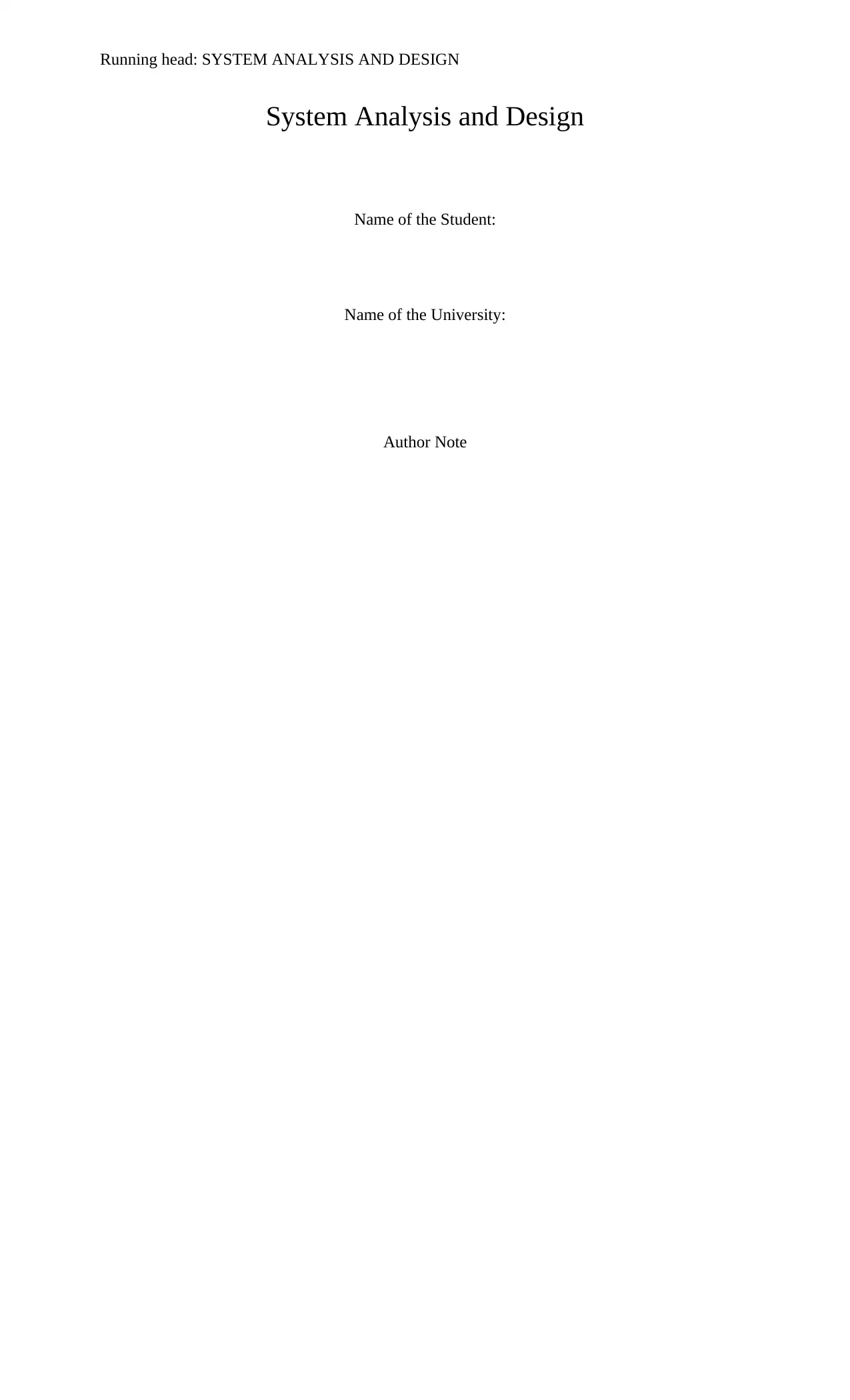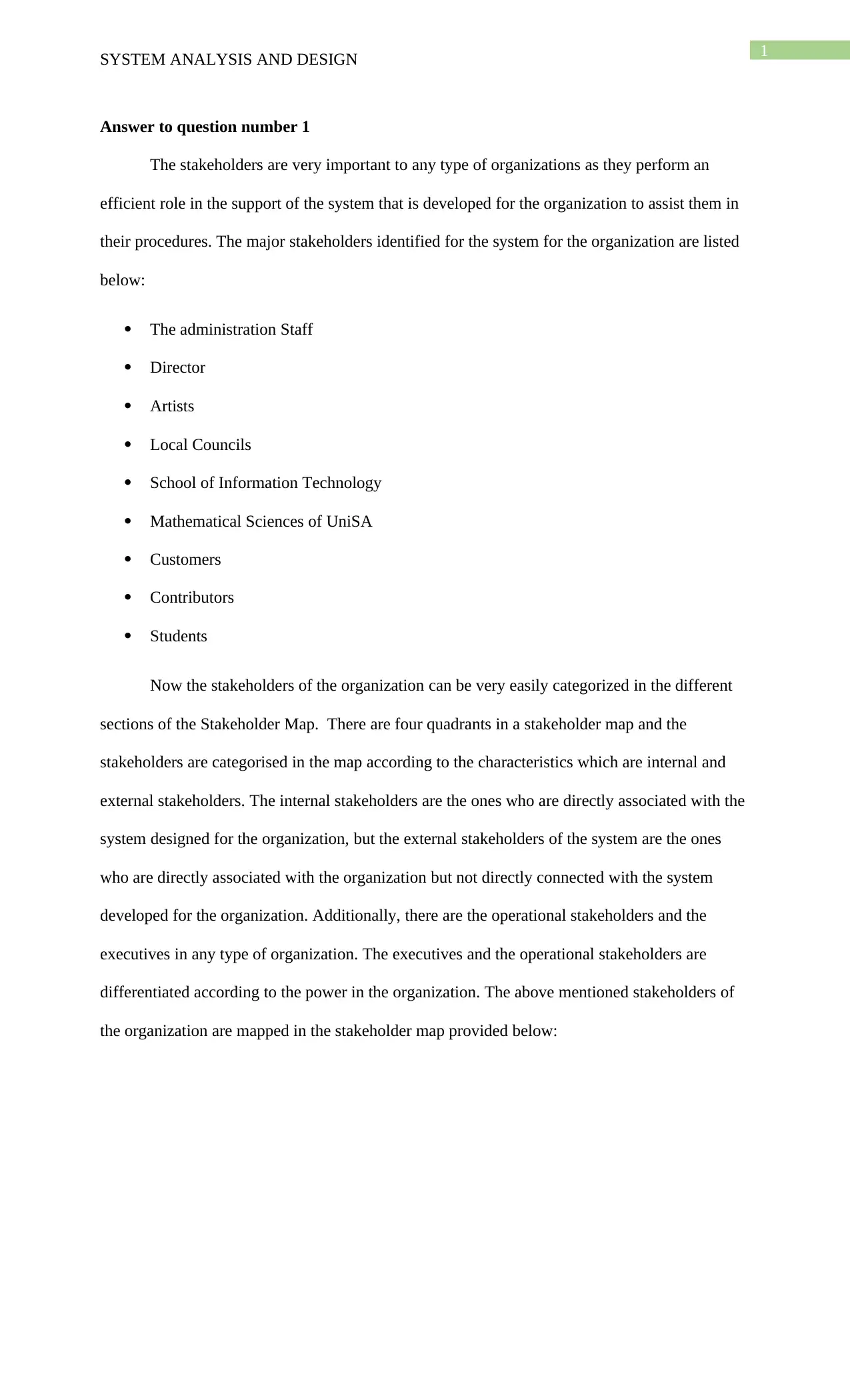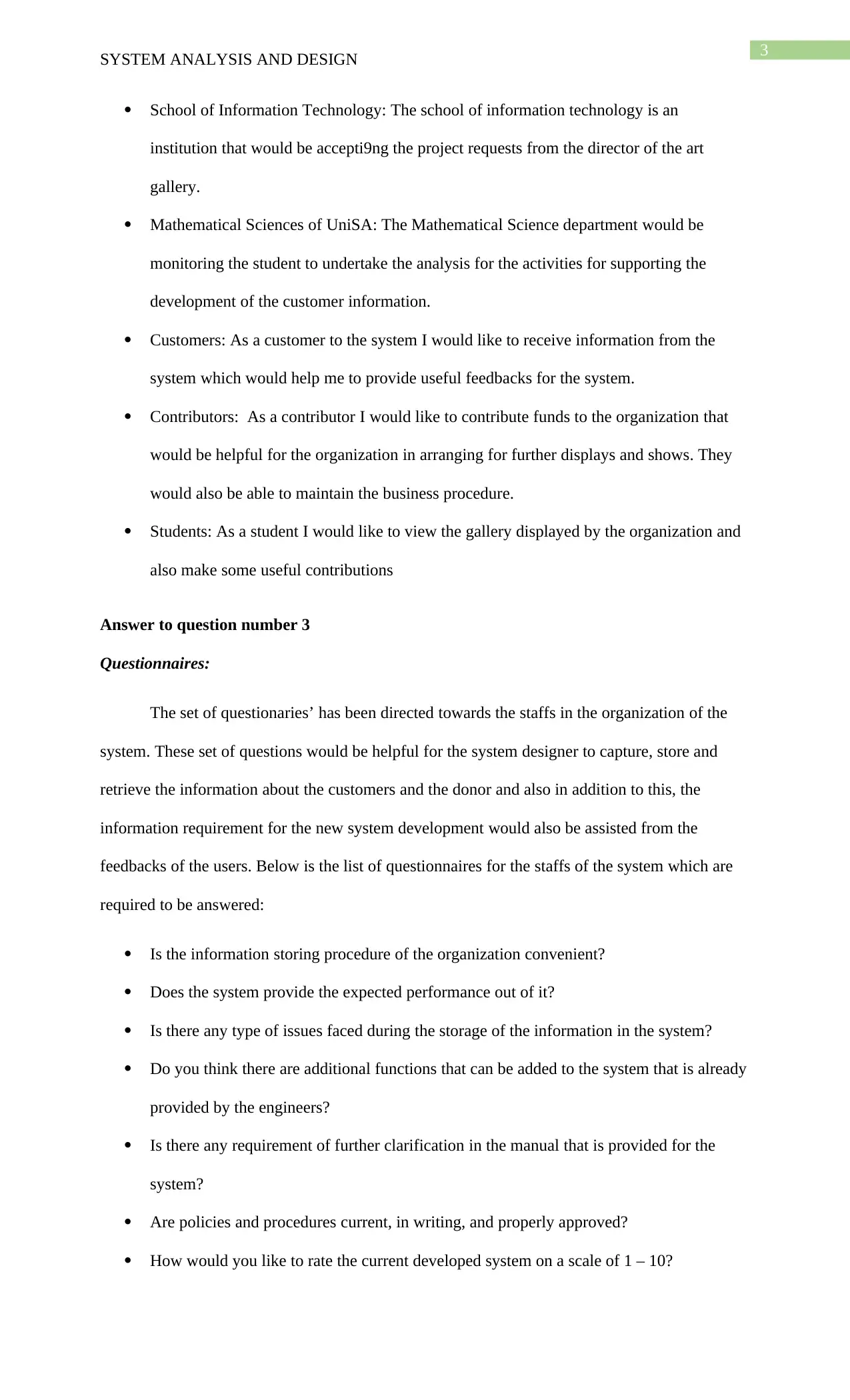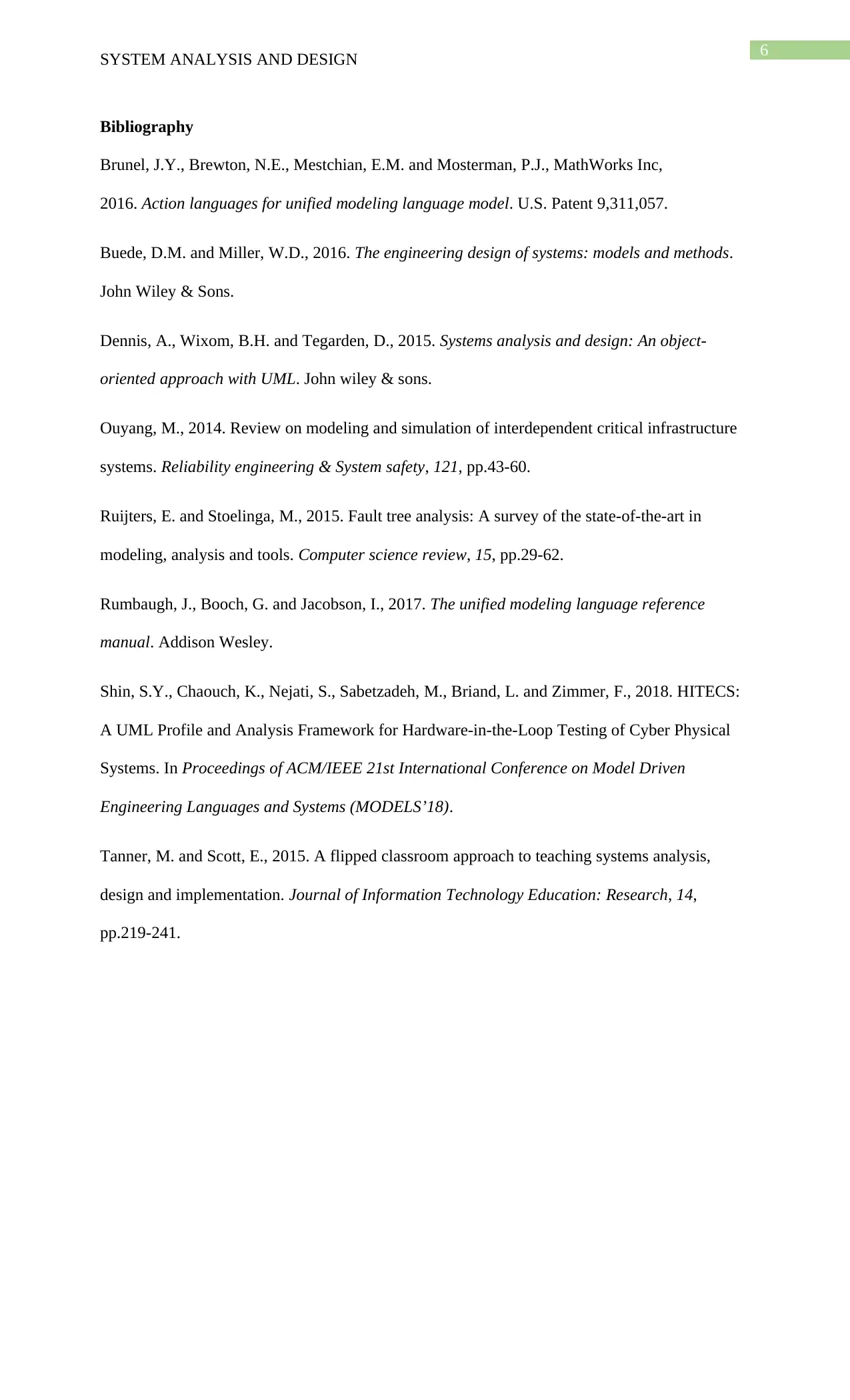System Analysis and Design: Stakeholder Analysis and System Modeling
VerifiedAdded on 2023/06/10
|7
|1515
|265
Report
AI Summary
This report provides a comprehensive analysis and design of a system, beginning with the identification and categorization of key stakeholders, including administration staff, directors, artists, local councils, IT schools, mathematical sciences departments, customers, contributors, and students. It details the roles of each stakeholder and their interaction with the system. The report includes sample questionnaires designed to gather information requirements from staff, focusing on system usability, data storage, and security. It also discusses the use of Microsoft Visio and Edraw Max as modeling tools for creating UML diagrams. Finally, it presents an activity diagram illustrating the process of making homemade ham and pineapple pizzas, demonstrating the application of system modeling techniques. Desklib offers this and many more solved assignments for students.

Running head: SYSTEM ANALYSIS AND DESIGN
System Analysis and Design
Name of the Student:
Name of the University:
Author Note
System Analysis and Design
Name of the Student:
Name of the University:
Author Note
Paraphrase This Document
Need a fresh take? Get an instant paraphrase of this document with our AI Paraphraser

1
SYSTEM ANALYSIS AND DESIGN
Answer to question number 1
The stakeholders are very important to any type of organizations as they perform an
efficient role in the support of the system that is developed for the organization to assist them in
their procedures. The major stakeholders identified for the system for the organization are listed
below:
The administration Staff
Director
Artists
Local Councils
School of Information Technology
Mathematical Sciences of UniSA
Customers
Contributors
Students
Now the stakeholders of the organization can be very easily categorized in the different
sections of the Stakeholder Map. There are four quadrants in a stakeholder map and the
stakeholders are categorised in the map according to the characteristics which are internal and
external stakeholders. The internal stakeholders are the ones who are directly associated with the
system designed for the organization, but the external stakeholders of the system are the ones
who are directly associated with the organization but not directly connected with the system
developed for the organization. Additionally, there are the operational stakeholders and the
executives in any type of organization. The executives and the operational stakeholders are
differentiated according to the power in the organization. The above mentioned stakeholders of
the organization are mapped in the stakeholder map provided below:
SYSTEM ANALYSIS AND DESIGN
Answer to question number 1
The stakeholders are very important to any type of organizations as they perform an
efficient role in the support of the system that is developed for the organization to assist them in
their procedures. The major stakeholders identified for the system for the organization are listed
below:
The administration Staff
Director
Artists
Local Councils
School of Information Technology
Mathematical Sciences of UniSA
Customers
Contributors
Students
Now the stakeholders of the organization can be very easily categorized in the different
sections of the Stakeholder Map. There are four quadrants in a stakeholder map and the
stakeholders are categorised in the map according to the characteristics which are internal and
external stakeholders. The internal stakeholders are the ones who are directly associated with the
system designed for the organization, but the external stakeholders of the system are the ones
who are directly associated with the organization but not directly connected with the system
developed for the organization. Additionally, there are the operational stakeholders and the
executives in any type of organization. The executives and the operational stakeholders are
differentiated according to the power in the organization. The above mentioned stakeholders of
the organization are mapped in the stakeholder map provided below:

2
Administration staff
Director
Artists
Students
Local council
School of Information
Technology
Mathematical Sciences Of UniSA
Customers
Contributors
SYSTEM ANALYSIS AND DESIGN
Answer to question number 2
The role for each of the stakeholders identified for the system are:
The administration Staff: As the administrative staff I would like to monitors and perform
the tasks of managing the inventory which would be containing the details of the painting
of the artist and this would help the organization in maintenance and monitoring the data
of the organization in the inventory and also the data handling tasks would be assisted by
this role.
Director: As the director of the organization I would like to monitor the different type of
aspects of the organization and see to it that the systems are maintained appropriately by
the staffs of the organization.
Artists: As an artist I would like to contribute to the organization by adding my painting
to the collection of the art gallery for the organization.
Local Councils: As the local council I would like to sponsor the house for the Artists R
Us organization so that the organization does not require to obtain any other building for
conducting the gallery for the artists of the organization.
Administration staff
Director
Artists
Students
Local council
School of Information
Technology
Mathematical Sciences Of UniSA
Customers
Contributors
SYSTEM ANALYSIS AND DESIGN
Answer to question number 2
The role for each of the stakeholders identified for the system are:
The administration Staff: As the administrative staff I would like to monitors and perform
the tasks of managing the inventory which would be containing the details of the painting
of the artist and this would help the organization in maintenance and monitoring the data
of the organization in the inventory and also the data handling tasks would be assisted by
this role.
Director: As the director of the organization I would like to monitor the different type of
aspects of the organization and see to it that the systems are maintained appropriately by
the staffs of the organization.
Artists: As an artist I would like to contribute to the organization by adding my painting
to the collection of the art gallery for the organization.
Local Councils: As the local council I would like to sponsor the house for the Artists R
Us organization so that the organization does not require to obtain any other building for
conducting the gallery for the artists of the organization.
⊘ This is a preview!⊘
Do you want full access?
Subscribe today to unlock all pages.

Trusted by 1+ million students worldwide

3
SYSTEM ANALYSIS AND DESIGN
School of Information Technology: The school of information technology is an
institution that would be accepti9ng the project requests from the director of the art
gallery.
Mathematical Sciences of UniSA: The Mathematical Science department would be
monitoring the student to undertake the analysis for the activities for supporting the
development of the customer information.
Customers: As a customer to the system I would like to receive information from the
system which would help me to provide useful feedbacks for the system.
Contributors: As a contributor I would like to contribute funds to the organization that
would be helpful for the organization in arranging for further displays and shows. They
would also be able to maintain the business procedure.
Students: As a student I would like to view the gallery displayed by the organization and
also make some useful contributions
Answer to question number 3
Questionnaires:
The set of questionaries’ has been directed towards the staffs in the organization of the
system. These set of questions would be helpful for the system designer to capture, store and
retrieve the information about the customers and the donor and also in addition to this, the
information requirement for the new system development would also be assisted from the
feedbacks of the users. Below is the list of questionnaires for the staffs of the system which are
required to be answered:
Is the information storing procedure of the organization convenient?
Does the system provide the expected performance out of it?
Is there any type of issues faced during the storage of the information in the system?
Do you think there are additional functions that can be added to the system that is already
provided by the engineers?
Is there any requirement of further clarification in the manual that is provided for the
system?
Are policies and procedures current, in writing, and properly approved?
How would you like to rate the current developed system on a scale of 1 – 10?
SYSTEM ANALYSIS AND DESIGN
School of Information Technology: The school of information technology is an
institution that would be accepti9ng the project requests from the director of the art
gallery.
Mathematical Sciences of UniSA: The Mathematical Science department would be
monitoring the student to undertake the analysis for the activities for supporting the
development of the customer information.
Customers: As a customer to the system I would like to receive information from the
system which would help me to provide useful feedbacks for the system.
Contributors: As a contributor I would like to contribute funds to the organization that
would be helpful for the organization in arranging for further displays and shows. They
would also be able to maintain the business procedure.
Students: As a student I would like to view the gallery displayed by the organization and
also make some useful contributions
Answer to question number 3
Questionnaires:
The set of questionaries’ has been directed towards the staffs in the organization of the
system. These set of questions would be helpful for the system designer to capture, store and
retrieve the information about the customers and the donor and also in addition to this, the
information requirement for the new system development would also be assisted from the
feedbacks of the users. Below is the list of questionnaires for the staffs of the system which are
required to be answered:
Is the information storing procedure of the organization convenient?
Does the system provide the expected performance out of it?
Is there any type of issues faced during the storage of the information in the system?
Do you think there are additional functions that can be added to the system that is already
provided by the engineers?
Is there any requirement of further clarification in the manual that is provided for the
system?
Are policies and procedures current, in writing, and properly approved?
How would you like to rate the current developed system on a scale of 1 – 10?
Paraphrase This Document
Need a fresh take? Get an instant paraphrase of this document with our AI Paraphraser

4
SYSTEM ANALYSIS AND DESIGN
How would like to measure the success in simplifying the procedures of the organization
after the implementation of the system?
How would like to determine the storage of the data in the system for the organization?
What are the security factors that are to be installed in the system so that the data stored
in the system are fully secured?
What are the possible filters that you would like to be enabled in your system so that data
can be inserted into the system?
Please state the feature of the system that you like to improve and also explain the proper
procedures which are to be taken so that the improvements in the system that would
increase the efficiency of the business procedures of the organization.
Answer to question number 4
The two modelling tools which would be used for the modelling of the diagrams for the
system are Microsoft Visio and Edraw Max. Microsoft Visio is the online tool that is free of cost
and Edraw Max is the tool that allows 30 days of trial period and has its charges for the users
after that. Microsoft Visio is a very useful tool that is used for the development of all type of
UML diagrams. It is free and also provides various type of facilities such as the Network
diagrams and also other models. In addition to this, the tool provides various type of themes and
colours for the distinction of the models and for making the models more and more attractive for
the users. On the other hand, Edraw Max is an all-in-one 2D business technical diagramming
software which help create flowcharts, organizational charts, mind map, network diagrams, floor
plans, workflow diagrams, business charts, and engineering diagrams. It is very efficient and
provides a trail period for the users and thereafter it exerts the charges from the users.
Answer to question number 5
The activity Diagram to make Jack home-made ham and pineapple pizzas has been
provided below:
SYSTEM ANALYSIS AND DESIGN
How would like to measure the success in simplifying the procedures of the organization
after the implementation of the system?
How would like to determine the storage of the data in the system for the organization?
What are the security factors that are to be installed in the system so that the data stored
in the system are fully secured?
What are the possible filters that you would like to be enabled in your system so that data
can be inserted into the system?
Please state the feature of the system that you like to improve and also explain the proper
procedures which are to be taken so that the improvements in the system that would
increase the efficiency of the business procedures of the organization.
Answer to question number 4
The two modelling tools which would be used for the modelling of the diagrams for the
system are Microsoft Visio and Edraw Max. Microsoft Visio is the online tool that is free of cost
and Edraw Max is the tool that allows 30 days of trial period and has its charges for the users
after that. Microsoft Visio is a very useful tool that is used for the development of all type of
UML diagrams. It is free and also provides various type of facilities such as the Network
diagrams and also other models. In addition to this, the tool provides various type of themes and
colours for the distinction of the models and for making the models more and more attractive for
the users. On the other hand, Edraw Max is an all-in-one 2D business technical diagramming
software which help create flowcharts, organizational charts, mind map, network diagrams, floor
plans, workflow diagrams, business charts, and engineering diagrams. It is very efficient and
provides a trail period for the users and thereafter it exerts the charges from the users.
Answer to question number 5
The activity Diagram to make Jack home-made ham and pineapple pizzas has been
provided below:

5
SYSTEM ANALYSIS AND DESIGN
The diagram has been created using MS Visio, as such type of diagrams and modelling
can be done very easily in this tool and also the tool is an open source tool.
SYSTEM ANALYSIS AND DESIGN
The diagram has been created using MS Visio, as such type of diagrams and modelling
can be done very easily in this tool and also the tool is an open source tool.
⊘ This is a preview!⊘
Do you want full access?
Subscribe today to unlock all pages.

Trusted by 1+ million students worldwide

6
SYSTEM ANALYSIS AND DESIGN
Bibliography
Brunel, J.Y., Brewton, N.E., Mestchian, E.M. and Mosterman, P.J., MathWorks Inc,
2016. Action languages for unified modeling language model. U.S. Patent 9,311,057.
Buede, D.M. and Miller, W.D., 2016. The engineering design of systems: models and methods.
John Wiley & Sons.
Dennis, A., Wixom, B.H. and Tegarden, D., 2015. Systems analysis and design: An object-
oriented approach with UML. John wiley & sons.
Ouyang, M., 2014. Review on modeling and simulation of interdependent critical infrastructure
systems. Reliability engineering & System safety, 121, pp.43-60.
Ruijters, E. and Stoelinga, M., 2015. Fault tree analysis: A survey of the state-of-the-art in
modeling, analysis and tools. Computer science review, 15, pp.29-62.
Rumbaugh, J., Booch, G. and Jacobson, I., 2017. The unified modeling language reference
manual. Addison Wesley.
Shin, S.Y., Chaouch, K., Nejati, S., Sabetzadeh, M., Briand, L. and Zimmer, F., 2018. HITECS:
A UML Profile and Analysis Framework for Hardware-in-the-Loop Testing of Cyber Physical
Systems. In Proceedings of ACM/IEEE 21st International Conference on Model Driven
Engineering Languages and Systems (MODELS’18).
Tanner, M. and Scott, E., 2015. A flipped classroom approach to teaching systems analysis,
design and implementation. Journal of Information Technology Education: Research, 14,
pp.219-241.
SYSTEM ANALYSIS AND DESIGN
Bibliography
Brunel, J.Y., Brewton, N.E., Mestchian, E.M. and Mosterman, P.J., MathWorks Inc,
2016. Action languages for unified modeling language model. U.S. Patent 9,311,057.
Buede, D.M. and Miller, W.D., 2016. The engineering design of systems: models and methods.
John Wiley & Sons.
Dennis, A., Wixom, B.H. and Tegarden, D., 2015. Systems analysis and design: An object-
oriented approach with UML. John wiley & sons.
Ouyang, M., 2014. Review on modeling and simulation of interdependent critical infrastructure
systems. Reliability engineering & System safety, 121, pp.43-60.
Ruijters, E. and Stoelinga, M., 2015. Fault tree analysis: A survey of the state-of-the-art in
modeling, analysis and tools. Computer science review, 15, pp.29-62.
Rumbaugh, J., Booch, G. and Jacobson, I., 2017. The unified modeling language reference
manual. Addison Wesley.
Shin, S.Y., Chaouch, K., Nejati, S., Sabetzadeh, M., Briand, L. and Zimmer, F., 2018. HITECS:
A UML Profile and Analysis Framework for Hardware-in-the-Loop Testing of Cyber Physical
Systems. In Proceedings of ACM/IEEE 21st International Conference on Model Driven
Engineering Languages and Systems (MODELS’18).
Tanner, M. and Scott, E., 2015. A flipped classroom approach to teaching systems analysis,
design and implementation. Journal of Information Technology Education: Research, 14,
pp.219-241.
1 out of 7
Related Documents
Your All-in-One AI-Powered Toolkit for Academic Success.
+13062052269
info@desklib.com
Available 24*7 on WhatsApp / Email
![[object Object]](/_next/static/media/star-bottom.7253800d.svg)
Unlock your academic potential
Copyright © 2020–2025 A2Z Services. All Rights Reserved. Developed and managed by ZUCOL.




